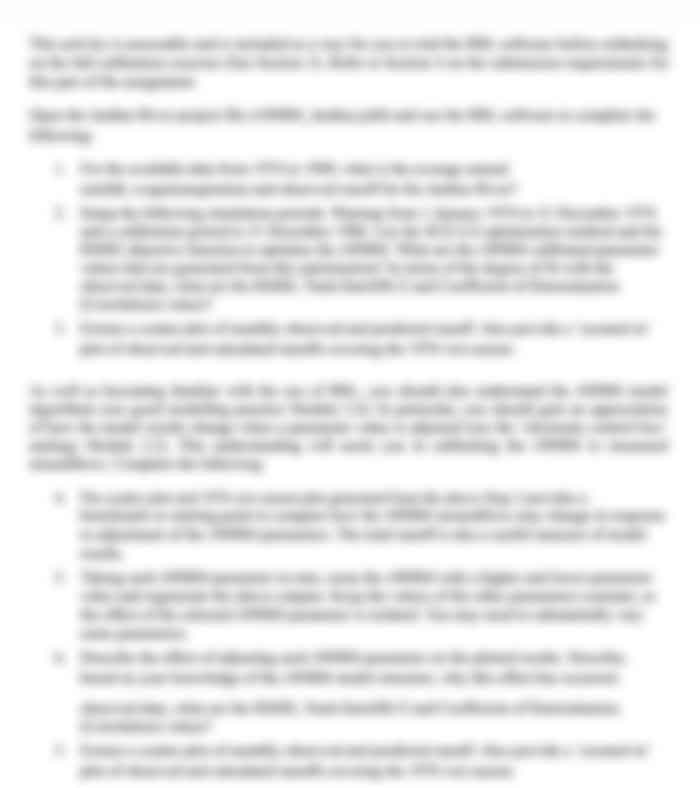ZZBU8701 ActiveInvestingandMulti-factorModels Assignment
- Subject Code :
ZZBU8701
Project3
1Task
You are a portfolio analyst determining an optimal active portfolio management strategy for yourPortfolioManager.Youarerequiredtoconstructanappropriatelyweightedactiveportfolioandallocatebetween this active portfolio and the market portfolio. You will then determine whether the Carhart 4-factormodelsignificantlyincreasestheexplanatorypowerofyouractiveportfoliosreturnsincomparison to the SIM. Finally, you will prepare a 3-minute presentation video to your PortfolioManager,whereyouwillpresentananalysis and comparisonofyour results.
2Context
- After evaluating various U.S. equities drawn from the S&P500, a number of stocks which exhibitsignificant alpha during the period from January 2014 to December 2018 have been identified.YourPortfolioManagerwantsyoutocarryoutanex-postanalysiswhichexamineshowanoptimalactive portfolio could have been formed from these alpha stocks which, when combined with anS&P500index ETF, wouldhavemaximised thecombinations Sharpe
- Theportfoliomanagerdecidestorandomlyallocatefiveuniquestockswhichexhibitedalphaduringthe sample period to each portfolio analyst to undertake their analysis.Each portfolio analyst willuseonly thesefive uniqueallocatedstocksto construct theiractive portfolio.
3AllocatedStocksandDataDownload
- Youhavebeenallocated5alpha(Notethatthesestocksareuniquetoyouandeachstudentwill have a different combination of stocks).Your allocated stocks will be posted on Moodle withyour Student ID in the Project 3 Stock Allocation Lookup.xls excel file in the Project 3Assessmentstab.
- Each stock in the spreadsheet is identified by its Factset identifier. Using these identifiers, for theperiodfromJanuary2014throughDecember2018,downloadthemonthlyreturnsforeachallocatedstock from FactSet (60 observations). All returns should be inclusive of dividends - in the FactSetdropdownbox "TotalReturn"select%"
- For the period from January 2014 through December 2018, download from FactSet the monthlyreturns for the S&P 500 Index (FactSet identifier: SP50) (60 observations). All returns should betotal returns inclusive of dividends - FactSet dropdown box: Total Return select % Return(Gross,Unhedged).
4SingleIndexModelRegressions(SecurityCharacteristicsLine)
- Usearisk-freerateof00%APR(i.e.fixedat 0.25%monthly) forthisanalysis.
- Foreachofthefivestocksinyouractiveportfolio,calculatemonthlyexcessreturn:
=?whereisthereturnonstockformonth,andistherisk-freerate.(Note:make sureyou use the fixed monthly risk-freerateabove).
- For the S&P 500 index, calculate monthly excess return: = ? where, is the returnontheS&P500formonth.ComputetheannualisedaverageexcessreturnfortheS&P500(simplyby multiplying the monthly excess return by 12). This will be the proxy for the average annualmarketrisk premiumoverthe sample period.
- EstimatetheSingleIndexModelalphaandbeta,(i.e.theSecurityCharacteristicLine)for eachstock inyouractive portfolio usingthe regressionequation:
=++
- Determine the residual variance (2) (unsystematic risk) for each stock in your active portfolio,eitherbyusingthefollowing equation:
2=22+2
Or byusingtheExcel regression tools.
- Annualise the alpha and the residual variance (unsystematic risk) by multiplying by 12. (Note:ensure your alphas are generated by regressing excess returns above the risk-free rate, not rawreturns).
5ConstructtheActivePortfolio
- Conduct confidence interval testing for each of your 5 stocks to confirm that the alpha is non-zero(significant) atthe 90%confidence
- As your Portfolio Manager is concerned that past alpha may not be reflected in future alpha, youarerequired torisk-weightthe alphas asfollows:
- Only include a stock in the active portfolio if its alpha is significant. Any stock that doesnot exhibit non-zero alpha at the 90% confidence level should be excluded from the activeportfolio
- Risk-weightthealphabymultiplyingitby10%whencalculatingeachstocksreward-to-riskForexample,iftheex-postalphawas20%p.a.fromtheSIMregression,thenumerator inyourrewardtorisk-calculationfor that stockwill be2%p.a.
- UsingtheTreynor-Blackmodel,appropriatelyweightyour active
6OptimallyCombinetheActivePortfolioandtheMarketPortfolio
- AssumeanETFthattrackstheS&P500isanappropriate proxyforthemarket portfolio.
- Derivethesamplevariance(2)oftheS&P500overthesampleperiodandannualise it.
- Usingtheactiveportfolioweightingsderivedin5above,calculatetheannualisedactiveportfolio
alpha,beta,andresidualvariance().Calculatethereward-to-riskratiofortheactive
portfolio(asa whole).
- Based on the reward-to-risk ratio of the market portfolio over the sample period. appropriatelyweight between the active portfolio and the market (passive) portfolio using the Treynor-Black
- Calculatetheannualisedinformationratioforeachstockinyourportfolio,aswellastheinformationratioforthe active portfolioas a whole.
- Calculate the potential improvement in your Sharpe ratio compared to a stand-alone investment inthe market (passive) portfolio as a result of this strategy.Verify how this result relates to theinformationratioofthe active portfolio (as a whole).
7ActivePortfolioReturns
- Usingtheactiveportfolioweightingsderivedin5above,aswellasthemonthlyreturnsdownloadedin3, calculatethemonthlyweighted active portfolioreturns for the sample
- Estimate the Single Index Model alpha and beta , for your weighted active portfolio (notethisistheactive portfolioSecurityCharacteristicLine) usingtheregressionequation:
=++
- Annualise the weighted active portfolio alpha , and determine if the alpha and beta aresignificant, as well as deriving the R2for the model over the sample period.Verify that the alphaand beta for the active portfolio (and ) are the same as your answer to 6 above. (Note:remember that your alpha in 6 was risk-weighted to be only 10% of the actual alpha, so the alphaderivedfromthisportfolioregressionshouldbeexactly10xtheactiveportfolioalphacalculatedin6).
8Multi-factorModel
- Open the excel file Fama French Carhart Factors.xls. This file contains the monthly riskpremiums (stated as decimals/percentages) for the Carhart 4-factor model over the sample period.(Note: checkthatthisisina compatibleformatto yourexisting dataintermsofdecimals).
- UsingtheFama-FrenchandCarhartmonthlyfactorportfoliodataprovided(SMB,HMLandWML)undertake a multi-factor regression analysis for each stock in your active portfolio.Derive thealpha (including its significance level) and R2for these 4-factor models for each stock in youractive
- Using the Fama-French and Carhart monthly factor portfolio data provided, undertake a multi-factorregressionanalysisforyourweightedactiveportfolio(usingtheactiveportfolioweightingsderivedin 5above,as wellas themonthlyreturns downloadedin 3). Usetheregressionequation:
- Derivethealpha(includingitssignificancelevel)andR2forthis4-factormodelregressionofyourweightedactive portfolio (Note:thisisone single regression).
9VideoPresentation
- Prepare a video for your Portfolio Manager of no longer than 3 minutes which discusses yourresults, as well as the limitations of your analysis. Some suggestions of what could be covered inyourvideoinclude:
- A brief discussion of the alpha of each stock in your active portfolio and why you believeitexists
- Howyouconstructedtheactiveportfolioandallocatedbetweenit andtheS&P500ETF
- A brief comment on the improvement in your Sharpe ratio arising from the addition of theactiveportfolio, comparedto holdingthe S&P500ETFalone
- Anexaminationofthedifferencesintheresultsderivedfromtheindividualstockregressionscomparedtotheactiveportfolioregression,referencingsuchstatisticalmeasuresastheR2andthealpha,andanyotherstatisticalmeasuresyoubelievearerelevant
- A discussion of what happens to your R2and alpha (including its significance), and anyother statistical measures you believe are relevant, when the additional Carhart factors areaddedto themodel, as wellas anexplanationforwhyyou believethis occurs
- A discussion of the differences between your multi-factor model individual stock resultsandyourmulti-factormodel portfolio result
- Considerationofanylimitationsorshortcomingsyoubelieveexistinyourmodels,addressingissuessuchastheriskweightingmethodology,allocationmethodologies,concentrationissuesandthe unconstrained natureofthe outcomes

